Photographer, mixologist, chef, promoter, traveler, cultural ambassador, Instagram superstar…. Omar Alonso covers a lot of ground, and the Oaxacking moniker, for which he’s most well-known, seems to capture all his different personas. For those unfamiliar with him, a good place to start is his Oaxacking Instagram, which features some of the best photos, videos, and commentary on Oaxacan culture, food, and art (including mezcal, of course). His tours, which can be booked through his website, are inclusive of some of the finest mezcal producers in Oaxaca, but they also feature a wider range of experiences that simply aren’t available with anyone else. Tyler and I first got in touch with Omar a few years ago, but it wasn’t until this spring 2019 that we were finally able to take a tour with him.
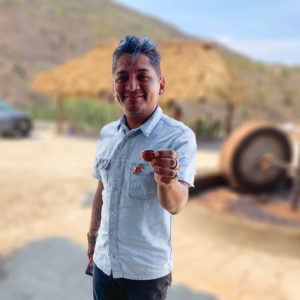
Omar Alonso (Oaxacking) holding the world’s smallest copita at the Hernandez Palenque (Mezcal Convite)
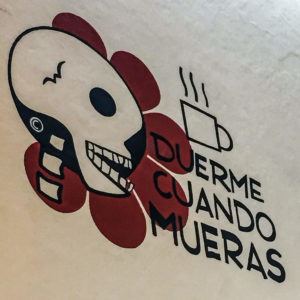
Coffee at Café Brújula in Oaxaca City. “Sleep when you’re dead,” written on the wall
Oaxacking through Oaxaca
He picked us up around the corner from our AirBnB in Centro and the first thing he asked us is if we needed coffee. As a 3rd generation coffee addict, I knew immediately that it was going to be a great day. We stopped by Café Brújula to grab ice coffees before zipping through the winding city streets and out into the Oaxacan countryside.
While driving through the early morning sun, we all got to know each other a little better. Omar’s parents are originally from the Oaxacan coast, but he grew up mostly in Oaxaca City. At age 18, he moved to Los Angeles and helped to bring the Guelaguetza restaurant to life. After spending several years in LA, he moved back to Oaxaca. When asked what he was doing in Oaxaca before he began giving tours, he said jokingly “hanging out with my friends.” While this was a funny response, it became apparent over the course of the day that he knows just about everyone in Oaxaca, so perhaps his statement was true.
He mentioned having spent some time working with Los Danzantes as well as organizing events related to music, photography, and mixology. He now does tours almost everyday, but he still tries to find time for these other activities. Most of the tours are booked through his Instagram, Oaxacking, the name of which is derived from “walking through Oaxaca” as if on a tour, not “the king of Oaxaca.” The conversation was lively as climbed out toward the mountains with his friends, La Santa Cecelia, blasting on the car stereo.
Teotitlán del Valle
Our first stop of the day was in Teotitlán del Valle to see some traditional weaving. They use only natural dyes and coloration, mixing traditional designs with more modern interpretations and forms. Chris purchased a small rug on our quick visit and we were once again on the road.
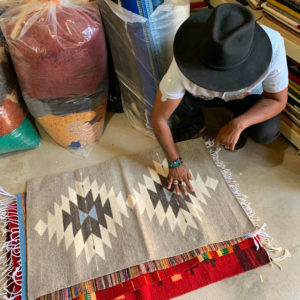
Omar describing the process of getting certain colors
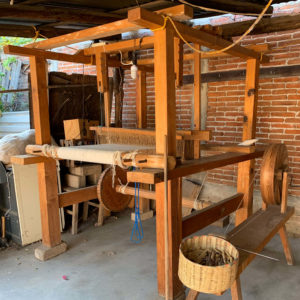
A loom used for hand weaving rugs and other fabrics in Teotitlan del Valle
The Tlacolula Sunday Market
Omar informed us that the Tlacolula Market is sometimes referred to as the “Gringo Market” by some locals. He still likes to go there because it’s a good experience, and he has friends there who make really good food. We’d actually visited this market in the past, but we’d only stopped at the first tlayuda stand and gone no further on our first visit. With Omar, we walked through a seemingly endless maze of vendors selling everything from fresh mangoes to clay pottery to sneakers and shoes. It was good to have him as a guide as we would have surely gotten lost. He took us clear across the market, which spanned several blocks, to a special area where we sipped some pulque and tepache with some of Omar’s friends who had produced it.
Once the pulque and tepache pours were finished, we headed out across a large open area in front of a very old, but well-maintained, church and into an entirely different portion of the market. The second half of the market was mostly comprised of people butchering, cooking, and selling meat and vegetables. We purchased some raw paper-thin steak flanks, raw chorizo links, and some fresh white onions. We took all of this and put it on one of the many open charcoal grills that filled the area around the raw meat and vegetables. Once cooked, we took the meats and onions to a table where we ordered beers, coffee, and tortillas. For those of us who were struggling from the previous night’s mezcal intake (mostly just me), this was one of the best meals ever eaten. Another vendor brought us some avocados mixed with other vegetables and a soup that also contained some cooked meats.
Considering Omar had labelled this the “Gringo Market,” I was surprised that we were the only gringos that we saw our entire time there. We finished our food, jumped into taxi motos and zipped around the massive market back to our car.
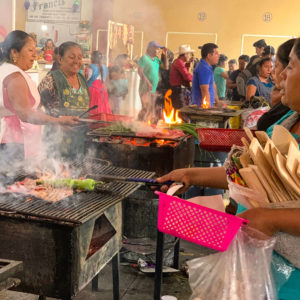
Cooking meats and vegetables at the Tlacolula Market
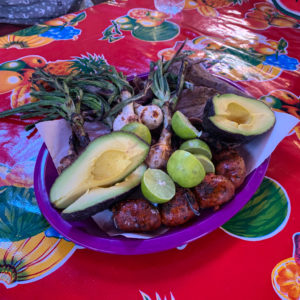
A breakfast fit for a (Oaxac)King at the market
Mezcal Ilegal
Omar had mentioned ahead of time that we’d be stopping by the market, visiting one of his friends who was making a Pechuga, and then finishing the tour with the renowned Lalo Angeles of Lalocura. After driving a while out of the market, he asked if we knew Mezcal Ilegal. Of course, we did. He then asked if we wanted to stop at their palenque. Of course, we did.
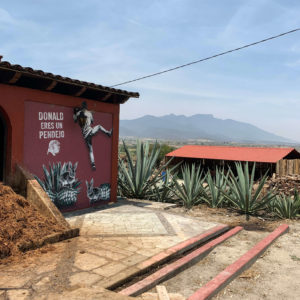
Outside the palenque of Alvaro and Armando Hernandez, producers of Mezcal Ilegal. Wall art by Lapiztola
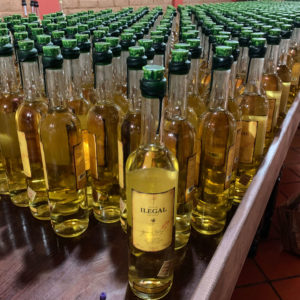
Mezcal Ilegal bottling room with new labels
This was the palenque of Alvaro and Armando Hernandez outside of Santiago Matatlan. While they’ve only been producing for Ilegal for a somewhat short period of time, they’ve been selling their own local brands, Amor de Mal and Ve Lua, successfully for many years. While Ilegal is always made with agave Espadin, their other brands are made with a wide variety of other agave.
Many of the Ilegal bottles available abroad are still certified under NOM-O01X, which was their old producer. The NOM for Alvaro and Armando is NOM-O305X. Check your bottles to see if they were made by the old or the new producers. Personally, I think that Alvaro and Armando (NOM-O305X) are making much more robust mezcal in comparison to what used to be available, but I might have a palenque bias (don’t things always taste much better after visiting the palenque?!).
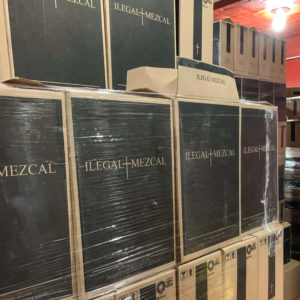
Palettes of Ilegal ready to ship
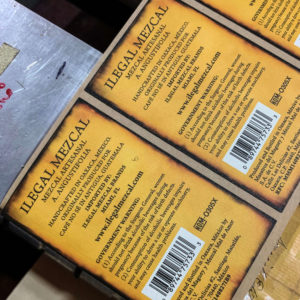
New labels with Alvaro’s and Armando’s NOM-O305X
After meeting Alvaro and Armando, Omar walked us through the palenque. As a whole, it was one of the cleanest operations I’ve ever seen (including Real Minero, which is also incredibly clean). Considering how popular Mezcal Ilegal has become in the US, the entire palenque was actually much smaller than I’d expected. They only have three underground pit ovens, two or three tahonas, and six-to-eight copper stills. The walls of the palenque are also decorated with art from Lapiztola, who is kind of known as the Banksy of Oaxaca.
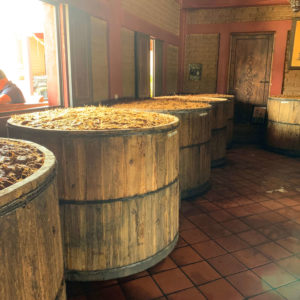
Ilegal Mezcal fermentation tanks
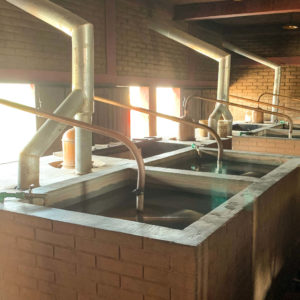
Ilegal Mezcal copper stills
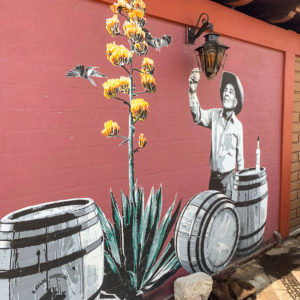
Artwork from Lapiztola decorates the walls of the palenque
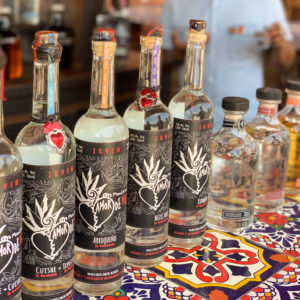
Alvaro and Armando Hernandez’s local brands Amor de Mal and Ve Lua
Pulque in Matatlan
We continued into Matatlan, picking up Carlos Isaac Mateo at his family’s home. With him in the trunk, we drove up to the top of the nearest mountain ridge to harvest aguamiel from some agave Salmiana that were producing the sweet delicious juice. Aguamiel is harvested by cutting the quiote and middle pencas from mature agave Salmiana. The bottom pencas and the entire pina are left in the ground. Three times a day, Carlos or a member of his family will come up to the field to scoop out fresh sugar water (aguamiel) from the opening in the top of the agave. The agave will continue producing the aguamiel for three months after they are initially cut. You can drink the sweet aguamiel, but Carlos typically allows it to ferment into pulque, which he sells locally.
After harvesting some fresh aguamiel, we went back to Carlos Isaac’s home to taste a few different pulques that he was making. We tasted some slightly fermented pulque, which had been harvested that morning and was still very sweet. We tasted some that had been harvested a week earlier, which was more tart, somewhat lactic, and had a much stronger alcohol punch. We also tasted some of the week-old pulque that was dressed with cinnamon and various other types of local wood and spice. Lastly, we tasted some of his mezcal, which was distilled from agave Salmiana that had not been used for pulque. Overall, it was an impressive tasting and it was great to see that Carlos, who is only 22 years old, was successfully taking over his family’s tradition of pulque production.
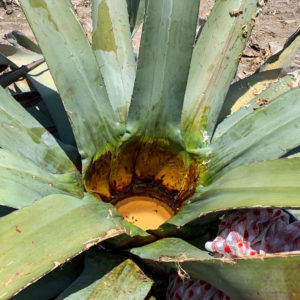
An open agave Salmiana full of aguamiel in Santiago Matatlan
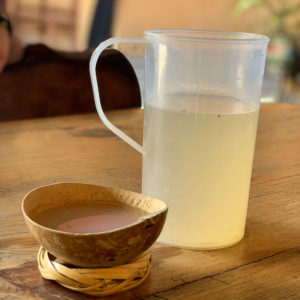
Fermented pulque and fresh aguamiel (in the pitcher)
Convite Mezcal
We stopped again in Santiago Matatlan to pick up some grilled chicken, which Omar knew we needed, and then we turned off the paved road and headed out to the palenque of Daniel and Tucho Hernandez in San Baltazar Guelavila. Their father, Don Cosme Hernandez, has produced many batches for both Alipus and the Mezcalero brand. Daniel and Tucho are brothers and have both been producing mezcal for most of their lives.
We talked to Daniel and Tucho for a couple hours while tasting their Coyote, Jabali, and Tobala. Daniel seems like more of the organized, business-type mezcalero, while Tucho, which means “wild” in Zapotec, was a bit more hands-on with the production. To our surprise, they both produce jointly for Convite Mezcal, which is just beginning to become available in the US and Canada as of the writing of this post. The pechuga they were making was on the final distillation. Daniel was pulling the mezcal straight from the still and adjusting it with spring water so that we could taste it at a variety of different ABVs.
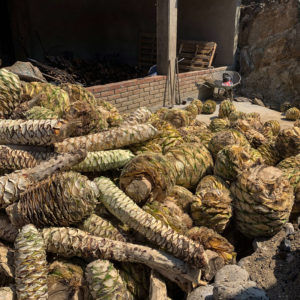
Uncooked agave at the palenque of Daniel and Tucho Hernandez, producers of Mezcal Convite
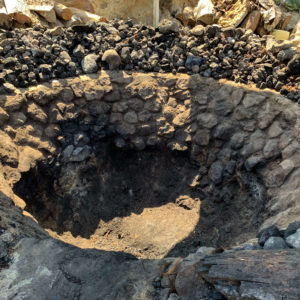
The pit oven used to cook Mezcal Convite
While we’ve seen many mezcaleros calculate ABV by hand, it still amazes me every time I see it. Typically the mezcalero will draw a bit of the mezcal through a bamboo shoot and then release the liquid in the bamboo shoot into a bowl or gourd, looking at the bubbles in the mezcal as a sign of the ABV. It’s incredible. We’ve purchased dozens of bottles directly from producers and in some cases we’ve actually gone back to the US and measured the ABV with more technical equipment. We’re yet to find a single discrepancy in what any mezcalero has ever gauged by hand.
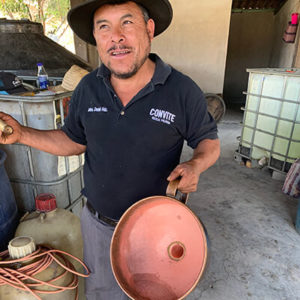
Maestro Mezcalero Daniel Hernandez, who works with his brother Tucho to produce Mezcal Convite
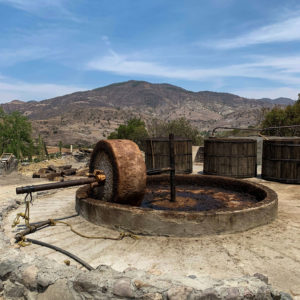
The tahona used to crush cooked agave at the palenque
Into the Night
After finishing up at Convite, we piled back into Omar’s car and headed to Santa Catarina Minas for our final visit of the day with Eduardo “Lalo” Angeles of Lalocura. Is was getting later, but we moved fast on the back roads past the palenque of Alberto Morales of Wahaka Mezcal, who we’d visited a few years ago.
As we drove, we chatted about our day thus far. We’d seen some traditional weaving, ate at a local market, harvested aguamiel for pulque, and visited several palenques of some well-known producers. Throughout it all, there was this overarching feeling that we were just hanging out with Omar’s friends and family. He had good relationships with everyone we visited and it made a huge difference as we were greeted with open arms everywhere we went. He knows a ton about mezcal and even more about Oaxaca and the people that make Oaxaca such an amazing place. We highly recommend Oaxacking if you’re interested in learning more about the rich culture that makes Oaxaca such a fascinating place. You can book tours with him directly at Oaxacking.com
It’d been an incredible day thus far and it would only get better once we arrived in Santa Catarina Minas. Read about the final stop of our tour in the blog post A Tour with Oaxacking: Mezcal Lalocura


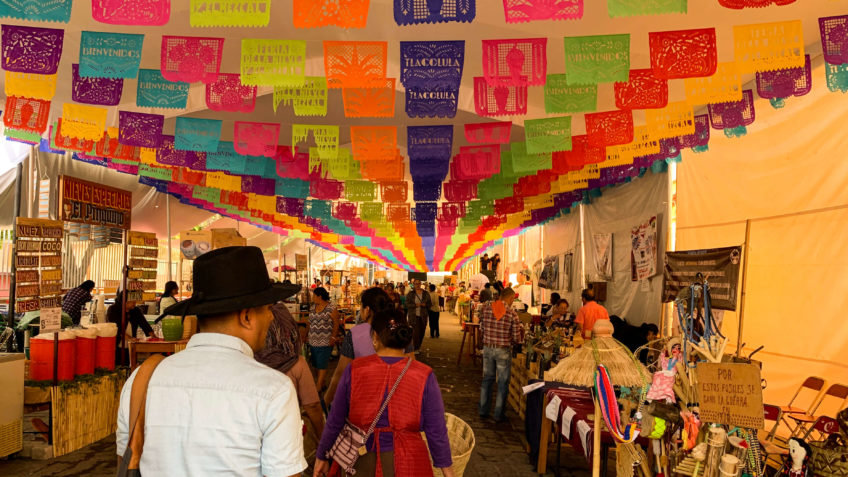


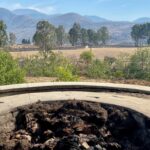
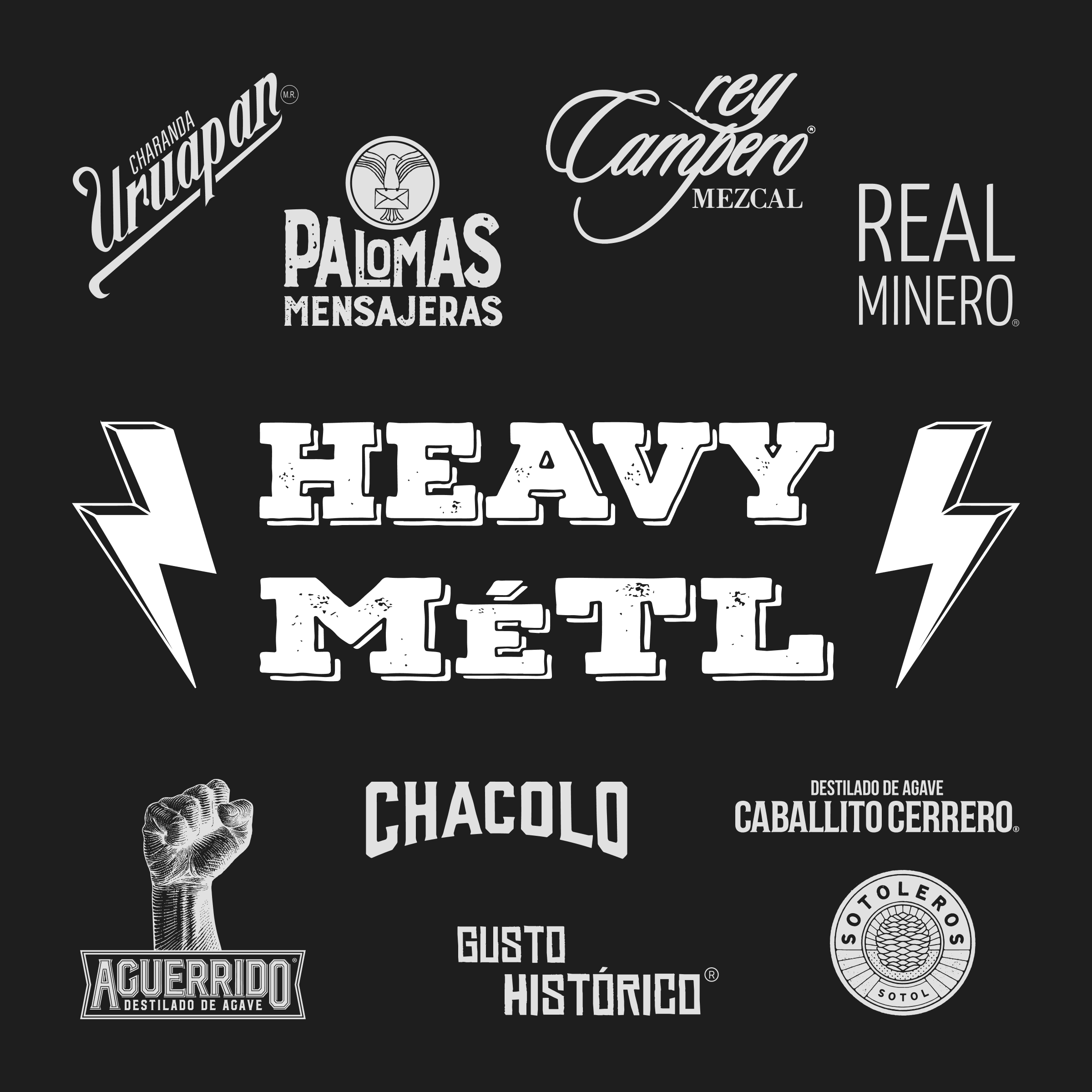
rsidrys
5 years agoSolid day!
“don’t things always taste much better after visiting the palenque?!” LOL, sooooooooooo true!!! So are you officially coining the term “palenque bias”?